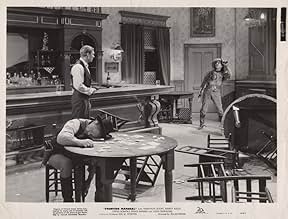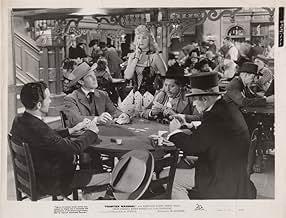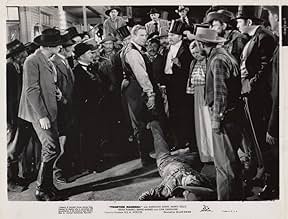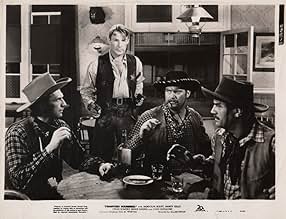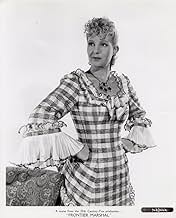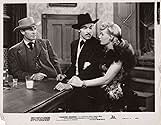CALIFICACIÓN DE IMDb
6.6/10
1.1 k
TU CALIFICACIÓN
Wyatt Earp acepta convertirse en alguacil y establecer el orden en Tombstone en esta versión tan romántica del tiroteo en el O.K. Corral.Wyatt Earp acepta convertirse en alguacil y establecer el orden en Tombstone en esta versión tan romántica del tiroteo en el O.K. Corral.Wyatt Earp acepta convertirse en alguacil y establecer el orden en Tombstone en esta versión tan romántica del tiroteo en el O.K. Corral.
- Premios
- 1 premio ganado en total
Dell Henderson
- Dave Hall
- (as Del Henderson)
Eddie Dunn
- Card Player
- (escenas eliminadas)
- Dirección
- Guionistas
- Todo el elenco y el equipo
- Producción, taquilla y más en IMDbPro
Opiniones destacadas
This was the movie which John Ford remade as his classic My Darling Clementine. Here, Randolph Scott plays Wyatt Earp and Caesar Romero plays Doc Holiday, but there are no Clantons or Earp brothers. Instead, John Carradine plays a bad saloon owner heading a gang that is trying to take over Tombstone.
Of course, this movie can't directly compare to My Darling Clementine, but it's a pretty good western in its own right. Its one of Randolph Scott's better early roles.
Many of the classic scenes in My Darling Clementine were taken directly from this movie, and it's very interesting to compare the two. This version of Frontier Marshal was a remake of an earlier 1933 version, and, of course, this story has been told many times since.
The Maltin Guide gives it three stars. Check it out if you're a western fan, or just a fan of My Darling Clementine.
Of course, this movie can't directly compare to My Darling Clementine, but it's a pretty good western in its own right. Its one of Randolph Scott's better early roles.
Many of the classic scenes in My Darling Clementine were taken directly from this movie, and it's very interesting to compare the two. This version of Frontier Marshal was a remake of an earlier 1933 version, and, of course, this story has been told many times since.
The Maltin Guide gives it three stars. Check it out if you're a western fan, or just a fan of My Darling Clementine.
For seventy-one minutes the film manages to fit in the deteriorating security situation in Tombstone as the camera flashes to the street for all the shootouts and horseplay. Compared to My Darling Clementine, this one is more easy going. Cesar Romero captures best acting over Vic Mature in the role of Doc Holliday, IMHO if only because Mature's part seemed overwrought, and the part of Holliday seems to fit Romero in a decisively more real way. Even still, the script in Frontier Marshal still caricatures Holliday as overly emotional, especially in the scenes in the saloon where he's purposely drinking himself to death because ex-flame Nancy Kelly comes in on the stage. Still, Romero was a great actor, and his scenes with Randolph Scott as Earp are a nice mix of two actors who had real naturalness. The B&W photography (Charles Clarke) stands out throughout and all the scenes in this movie are well assembled. It is over before you know it.
I'm not a huge fan of the Western genre but there are a few Westerns that really enjoy - this film goes into the my liked Western films. It is highly fictionalized version of the events that lead up to the famous gun fight but really fun to watch.
I have to say I enjoyed the entire cast which is one of the reasons why I like this film - it's not just the story and action on screen but the actors themselves that makes this particular film worth watching to me.
Binnie Barnes as Jerry - she really tickled me, constantly trying to keep up her tough exterior but in the end we saw the softer side of Jerry. A character I really liked watching.
Scott and Romero were good together. While Carradine, Chaney and Sawyer was made a great trio of "villains". You can't but to laugh as some of the things that happens - in particular when Doc Halliday (Romeo) gets Pringle (Chaney) to dance... lol.
Anyway, this one worth checking out if you haven't seen it already. Fictionalized Fun.
8.5/10
I have to say I enjoyed the entire cast which is one of the reasons why I like this film - it's not just the story and action on screen but the actors themselves that makes this particular film worth watching to me.
Binnie Barnes as Jerry - she really tickled me, constantly trying to keep up her tough exterior but in the end we saw the softer side of Jerry. A character I really liked watching.
Scott and Romero were good together. While Carradine, Chaney and Sawyer was made a great trio of "villains". You can't but to laugh as some of the things that happens - in particular when Doc Halliday (Romeo) gets Pringle (Chaney) to dance... lol.
Anyway, this one worth checking out if you haven't seen it already. Fictionalized Fun.
8.5/10
Randolph Scott, as Wyatt Earp, rides into Tombstone thinking about starting a stagecoach line. But Indian Charlie, drunk, starts shooting up the local saloon. The local marshal (Ward Bond) is afraid to go in and roust Charlie, so Earp dons a badge, goes in and drags him out by the feet. Earp becomes the full-time marshal. He meets Doc Halliday (Caesar Romero), a tubercular physician, gambler, and gunman, and after an initial wary brush, the two become more or less friends. Romero has a local trashy girlfriend (Binnie Barnes) whom Scott has to dump in a water trough. Doc gets liquored up, pulls his gun at the bar, and Earp knocks him out to save his life. An old flame of Doc's (Nancy Kelly) shows up in town, having pursued Doc all across the West, but Doc dumps her unceremoniously because he loathes what he's become. He redeems himself, however, by saving a badly wounded patient, only to be killed by Curly Bill and his gang as he walks out of the saloon door. There follows a shootout at the OK Corral in which Scott makes mincemeat of the bad guys. Binnie Barnes leaves town on the stage, and Kelly stays behind, probably not unaware of the moon eyes Scott has been casting her way.
Sound at all familiar? Seven years later it was remade as John Ford's "My Darling Clementine."
It isn't a bad movie, better than the majority of Westerns being made at the time. Yet one can't help wondering what makes Allan Dwan's "Frontier Marshal" an above-average Western and Ford's "My Darling Clementine" a classic.
Small things first. Dwan's movie is short on creativity in the wardrobe and makeup departments. Like most of the other principals, Scott dresses in an echt-1939 suit, only with a cowboy hat and gunbelt. The women's makeup dates badly, with dos out of the late 1930s and pencilled eyebrows and big lashes. It isn't that "Clementine" is extremely good in those respects -- it's just better.
The photography and location shooting don't reach the bar set by "Clementine" either. The photography isn't bad at all but it hardly fits into a Western frame. Almost the entire movie is shot at night, with no more than a handful of daylight scenes. The location isn't Monument Valley but it is, after all, Movie Flats which has been used expressively before. Here, it's not really present in any utilitarian sense because you can't SEE it at night.
Acting. Caesar Romero is probably as good as Victor Mature was in the later version. Binnie Barnes and Linda Darnell (in the same hooker role) are equally good, although they give us two quite different versions of what a hooker is like. Barnes is older, tougher looking, a bit treacherous. Darnell is younger, more Hispanic, tousle-haired, tempestuous, and childish. Scott is a competent actor, but Fonda is on the other hand outstanding. Throughout "Clementine" Fonda wears an expression that has something of puzzlement in it. When he whacks a guy over the head with the barrel of his pistol, he looks up from the unconscious body as if he's slightly surprised at what has happened and hasn't got a very clear idea of what's going to take place next.
Above all, there is the difference in direction. Dwan was a forthright story teller, a pioneer in the movies, and he does a good job. But Ford goes beyond the story, almost into visual poetry. "Clementine" has not only the family, but two opposing families, which gives the characters added depth and more intense motives. "Clementine" also has the familiar Ford opposition between the wilderness and the garden, which in Dwan's film is given very short shrift indeed. There is nothing in "Frontier Marshal" like the scene in which Fonda escorts Cathy Downs to the half-built church and awkwardly dances with her. What a celebration of community. Dwan's story deals with individuals who have conflicting ideas of how to get ahead. A couple of people know one another but there is little sense of a "town" in Dwan's movie. I won't go on about Ford's touches of roughhouse humor except to mention that they add another element lacking in "Frontier Marshal." There's an intentionality behind these brief incidents. Instance Fonda's dance with his feet against the porch post, or Darnell throwing a pitcher of milk in Ward Bond's face after he whinnies at her.
Still -- allright, so it's not a classic. But "Frontier Marshal" is better than most. And it's worth seeing for its historical value, a kind of lesson about how to make a good movie into a very good movie indeed.
Sound at all familiar? Seven years later it was remade as John Ford's "My Darling Clementine."
It isn't a bad movie, better than the majority of Westerns being made at the time. Yet one can't help wondering what makes Allan Dwan's "Frontier Marshal" an above-average Western and Ford's "My Darling Clementine" a classic.
Small things first. Dwan's movie is short on creativity in the wardrobe and makeup departments. Like most of the other principals, Scott dresses in an echt-1939 suit, only with a cowboy hat and gunbelt. The women's makeup dates badly, with dos out of the late 1930s and pencilled eyebrows and big lashes. It isn't that "Clementine" is extremely good in those respects -- it's just better.
The photography and location shooting don't reach the bar set by "Clementine" either. The photography isn't bad at all but it hardly fits into a Western frame. Almost the entire movie is shot at night, with no more than a handful of daylight scenes. The location isn't Monument Valley but it is, after all, Movie Flats which has been used expressively before. Here, it's not really present in any utilitarian sense because you can't SEE it at night.
Acting. Caesar Romero is probably as good as Victor Mature was in the later version. Binnie Barnes and Linda Darnell (in the same hooker role) are equally good, although they give us two quite different versions of what a hooker is like. Barnes is older, tougher looking, a bit treacherous. Darnell is younger, more Hispanic, tousle-haired, tempestuous, and childish. Scott is a competent actor, but Fonda is on the other hand outstanding. Throughout "Clementine" Fonda wears an expression that has something of puzzlement in it. When he whacks a guy over the head with the barrel of his pistol, he looks up from the unconscious body as if he's slightly surprised at what has happened and hasn't got a very clear idea of what's going to take place next.
Above all, there is the difference in direction. Dwan was a forthright story teller, a pioneer in the movies, and he does a good job. But Ford goes beyond the story, almost into visual poetry. "Clementine" has not only the family, but two opposing families, which gives the characters added depth and more intense motives. "Clementine" also has the familiar Ford opposition between the wilderness and the garden, which in Dwan's film is given very short shrift indeed. There is nothing in "Frontier Marshal" like the scene in which Fonda escorts Cathy Downs to the half-built church and awkwardly dances with her. What a celebration of community. Dwan's story deals with individuals who have conflicting ideas of how to get ahead. A couple of people know one another but there is little sense of a "town" in Dwan's movie. I won't go on about Ford's touches of roughhouse humor except to mention that they add another element lacking in "Frontier Marshal." There's an intentionality behind these brief incidents. Instance Fonda's dance with his feet against the porch post, or Darnell throwing a pitcher of milk in Ward Bond's face after he whinnies at her.
Still -- allright, so it's not a classic. But "Frontier Marshal" is better than most. And it's worth seeing for its historical value, a kind of lesson about how to make a good movie into a very good movie indeed.
Early version of the Earp-Holliday, OK Corral legend.
Thanks to big-budget TCF, this is a well-produced, mid-level Western. Those barroom scenes along with the crowded streets are high energy and appropriate to a boomtown, which Tombstone was. Dwan directs these scenes with flair. Can't say the same for the final shootout that is poorly staged and fleetingly done as if the production had to hurry up to meet schedule. Ford's 1946 remake My Darling Clementine greatly improves on that final showdown with the kind of close-ups and structured tension that're needed.
Scott and Romero cut formidable figures as the legendary heroes. The screenplay suffers, however, by failing to spotlight an equally formidable villain to challenge them, spreading the villainy instead across several minor players. Too bad the impressive Carradine is largely wasted in an incidental role. On the other hand, Kelly is very pretty as the good girl, while Barnes shines as the good-time girl. I like the way their rivalry evolves over time.
I can see why the estimable John Ford saw so much potential in the characters and story. There's a lot of color in the array of personalities and rivalries, including the show biz Eddie Foy Jr., an entertaining contrast to the frontier types. Of course, Ford's version is clearly superior. Still, this 1939 entry remains a respectable little Western with its own modest merits.
Thanks to big-budget TCF, this is a well-produced, mid-level Western. Those barroom scenes along with the crowded streets are high energy and appropriate to a boomtown, which Tombstone was. Dwan directs these scenes with flair. Can't say the same for the final shootout that is poorly staged and fleetingly done as if the production had to hurry up to meet schedule. Ford's 1946 remake My Darling Clementine greatly improves on that final showdown with the kind of close-ups and structured tension that're needed.
Scott and Romero cut formidable figures as the legendary heroes. The screenplay suffers, however, by failing to spotlight an equally formidable villain to challenge them, spreading the villainy instead across several minor players. Too bad the impressive Carradine is largely wasted in an incidental role. On the other hand, Kelly is very pretty as the good girl, while Barnes shines as the good-time girl. I like the way their rivalry evolves over time.
I can see why the estimable John Ford saw so much potential in the characters and story. There's a lot of color in the array of personalities and rivalries, including the show biz Eddie Foy Jr., an entertaining contrast to the frontier types. Of course, Ford's version is clearly superior. Still, this 1939 entry remains a respectable little Western with its own modest merits.
¿Sabías que…?
- TriviaCharles Stevens, who plays a drunken Indian, repeats the role in director John Ford's remake, La pasión de los fuertes (1946). Stevens, who was half Mexican and half Apache, was the grandson of legendary Apache warrior Geronimo.
- ErroresThe film has Doc Holliday being shot to death in an ambush by Curly Bill Brocius shortly before the shootout at the O.K. Corral in Tombstone, Arizona, on October 26. 1881. In reality, Holliday died of consumption in Glenwood Springs, Colorado, on November 8, 1887.
- Citas
Sarah Allen: John...
John 'Doc' Halliday: Yes, Sarah?
Sarah Allen: Isn't it more thrilling to give life than take it away?
- ConexionesFeatured in Fejezetek a film történetéböl: Amerikai filmtípusok - A western (1989)
- Bandas sonorasRock-a-Bye Baby
(1886) (uncredited)
Music and Lyrics by Effie I. Canning
Sung by Margaret Brayton a cappella
Selecciones populares
Inicia sesión para calificar y agrega a la lista de videos para obtener recomendaciones personalizadas
- How long is Frontier Marshal?Con tecnología de Alexa
Detalles
- Tiempo de ejecución
- 1h 11min(71 min)
- Color
- Relación de aspecto
- 1.37 : 1
Contribuir a esta página
Sugiere una edición o agrega el contenido que falta

